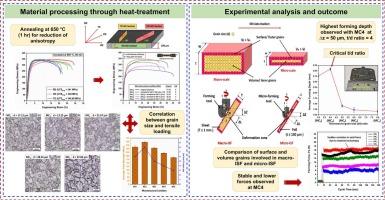An investigation of the formability of ultra-thin CP-Ti-Gr2 foils considering thickness-to-grain-size effects under controlled heat treatment in μ-ISF
IF 6.1
1区 工程技术
Q1 ENGINEERING, MANUFACTURING
引用次数: 0
Abstract
Micro-forming is an emerging micro-manufacturing process for the fabrication of miniature parts/components made of ultra-thin sheets (foils), forged billets, rods, etc. Achieving high formability in the micro-incremental sheet forming (μISF) process is difficult due to the size-effect and non-optimal selection of process parameters viz. step depth (∆z). The major sources of size-effects are pure volume source, surface-to-volume ratio, thickness-to-grain-size (t/d ratio), surface structure scalability, etc. In the micro-scale processes, studying the grain size of the material is crucial to understand the deformation behaviour. Additionally, the anisotropy is very prominent in thin foils and affects the micro-forming process adversely. In the present work, the intrinsic anisotropy of the foils is minimized through controlled heat treatment, and varying grain sizes, having different microstructures, are generated to investigate their effect on the formability of CP-Ti-Gr2 foils. Initially, the properties of the received material are tested along different directions through the uniaxial tensile test, followed by furnace annealing to produce equiaxed recrystallized grains and reduce the anisotropy of the foils. Subsequently, the specimens are heat-treated at different temperatures to generate a wide spectrum of grain sizes. Through extensive μISF experiments, it was established that higher annealing temperature and increase in grain size assisted in improving the ductility of the foils, leading to enhanced formability. Therefore, the combined effect of the grain size and step depth on the formability of the components is investigated. A relationship between formability and t/d ratio was established and its critical value was obtained. Interesting observations, contrary to those in macro-ISF process were observed, e.g. higher step depth in μISF helped in improving the formability of the micro-parts. The results were confirmed by measuring the forming forces during the process, and it presented a strong correlation with the yield stress values, further correlated with varying grain sizes of the foil. This work could pave the way for designing the μISF process parameters considering the size-effects at micro-scale deformation, through optimum t/d ratio, for maximizing the formability.

超薄 CP-Ti-Gr2 箔在 μ-ISF 受控热处理条件下的成型性研究,考虑厚度-晶粒尺寸效应
微型成形是一种新兴的微型制造工艺,用于制造由超薄板(箔)、锻造坯料、棒材等制成的微型零件/组件。由于尺寸效应和步进深度(Δz)等工艺参数的非最佳选择,在微增薄板成形(μISF)工艺中实现高成形性十分困难。尺寸效应的主要来源是纯体积源、表面-体积比、厚度-晶粒尺寸(t/d 比)、表面结构可扩展性等。在微尺度过程中,研究材料的晶粒尺寸对了解变形行为至关重要。此外,各向异性在薄金属箔中非常突出,会对微成型工艺产生不利影响。在本研究中,通过控制热处理使薄片的内在各向异性最小化,并生成具有不同微观结构的不同晶粒大小,以研究它们对 CP-Ti-Gr2 薄片成型性的影响。首先,通过单轴拉伸试验沿不同方向测试接收材料的性能,然后进行炉内退火,以产生等轴再结晶晶粒并降低箔的各向异性。随后,在不同温度下对试样进行热处理,以产生各种晶粒尺寸。通过大量的 μISF 实验,确定了较高的退火温度和晶粒大小的增加有助于改善铝箔的延展性,从而提高成型性。因此,我们研究了晶粒大小和台阶深度对部件成型性的综合影响。研究确定了成型性与 t/d 比率之间的关系,并得出了其临界值。观察到了与宏观 ISF 工艺相反的有趣现象,例如,μISF 中较高的台阶深度有助于改善微型部件的成型性。测量过程中的成型力证实了这一结果,它与屈服应力值密切相关,并与箔的不同晶粒尺寸进一步相关。这项工作可以为设计 μISF 工艺参数铺平道路,考虑到微尺度变形时的尺寸效应,通过最佳的 t/d 比,最大限度地提高成形性。
本文章由计算机程序翻译,如有差异,请以英文原文为准。
求助全文
约1分钟内获得全文
求助全文
来源期刊

Journal of Manufacturing Processes
ENGINEERING, MANUFACTURING-
CiteScore
10.20
自引率
11.30%
发文量
833
审稿时长
50 days
期刊介绍:
The aim of the Journal of Manufacturing Processes (JMP) is to exchange current and future directions of manufacturing processes research, development and implementation, and to publish archival scholarly literature with a view to advancing state-of-the-art manufacturing processes and encouraging innovation for developing new and efficient processes. The journal will also publish from other research communities for rapid communication of innovative new concepts. Special-topic issues on emerging technologies and invited papers will also be published.
 求助内容:
求助内容: 应助结果提醒方式:
应助结果提醒方式:


